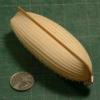-
Posts
13,306 -
Joined
-
Last visited
Content Type
Profiles
Forums
Gallery
Events
Everything posted by druxey
-

2nd rate London 1656 – the art of the shipwright
druxey replied to Waldemar's topic in Nautical/Naval History
Interesting, entertaining and educational! In my case, Richard, my viewpoint would only be 1¼" above a plan at 1:48 scale; an even more restricted and myopic view. -

2nd rate London 1656 – the art of the shipwright
druxey replied to Waldemar's topic in Nautical/Naval History
Every best wish for a successful March 4 rally! Unfortunately many of us do not live in the U.K. and won't be able to attend. -
Filler is no shame. Either auto body putty or a good wood filler such as LePage's will work.
- 40 replies
-
- Lowell Grand Banks Dory
- Model Shipways
-
(and 1 more)
Tagged with:
-

2nd rate London 1656 – the art of the shipwright
druxey replied to Waldemar's topic in Nautical/Naval History
Welcome aboard, Richard! The last line of your post has been truncated, though. What is this march? -
Nicely fixed, Keith. It's annoying enough having to re-do things inside a maze of obstacles, but misplacing a block as well.... Anyway, well done.
-
Comng along nicely. That 'punky' bit of plank must have had a flaw in the wood. You did an excellent job of repairing it. Sometimes stuff just happens with a natural material like wood.
- 38 replies
-
- Norwegian Sailing Pram
- Model Shipways
-
(and 2 more)
Tagged with:
-
You are doing well with that tricky stern shape!
- 144 replies
-
- Harriet Lane
- Model Shipways
-
(and 1 more)
Tagged with:
-
Try using the alcohol under Saran wrap so it stays where needed. Also, perhaps your spring clips are too strong?
- 40 replies
-
- Lowell Grand Banks Dory
- Model Shipways
-
(and 1 more)
Tagged with:
-

EURYALUS 1803 by Peter6172 - 1:48
druxey replied to Peter6172's topic in - Build logs for subjects built 1801 - 1850
I've always used rubber cement for this. The paper will peel off easily and the remains of the cement can be removed using a rubber cement eraser (it is crêpe rubber). -

HMS Euryalus 1803 by rlb - 1:48 scale
druxey replied to rlb's topic in - Build logs for subjects built 1801 - 1850
Persistence pays off!- 122 replies
-
- Euryalus
- Plank-on-frame
-
(and 4 more)
Tagged with:
-
There were often variances between different ships of ehe same class, so your finding is not unusual. What program are you using, BTW?
- 55 replies
-

3D cannon barrels
druxey replied to allanyed's topic in CAD and 3D Modelling/Drafting Plans with Software
A very nice offer, Allan. -

EURYALUS 1803 by Peter6172 - 1:48
druxey replied to Peter6172's topic in - Build logs for subjects built 1801 - 1850
Just catching up on your work, Peter. Nice and crisp!
About us
Modelshipworld - Advancing Ship Modeling through Research
SSL Secured
Your security is important for us so this Website is SSL-Secured
NRG Mailing Address
Nautical Research Guild
237 South Lincoln Street
Westmont IL, 60559-1917
Model Ship World ® and the MSW logo are Registered Trademarks, and belong to the Nautical Research Guild (United States Patent and Trademark Office: No. 6,929,264 & No. 6,929,274, registered Dec. 20, 2022)
Helpful Links
About the NRG
If you enjoy building ship models that are historically accurate as well as beautiful, then The Nautical Research Guild (NRG) is just right for you.
The Guild is a non-profit educational organization whose mission is to “Advance Ship Modeling Through Research”. We provide support to our members in their efforts to raise the quality of their model ships.
The Nautical Research Guild has published our world-renowned quarterly magazine, The Nautical Research Journal, since 1955. The pages of the Journal are full of articles by accomplished ship modelers who show you how they create those exquisite details on their models, and by maritime historians who show you the correct details to build. The Journal is available in both print and digital editions. Go to the NRG web site (www.thenrg.org) to download a complimentary digital copy of the Journal. The NRG also publishes plan sets, books and compilations of back issues of the Journal and the former Ships in Scale and Model Ship Builder magazines.



